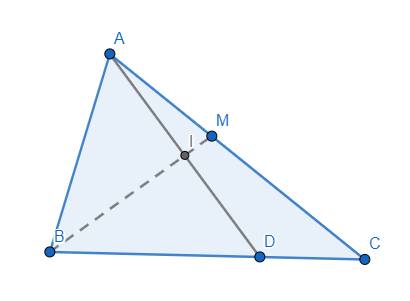Hãy nhập câu hỏi của bạn vào đây, nếu là tài khoản VIP, bạn sẽ được ưu tiên trả lời.

Xét ΔBAD có BI là đường trung tuyến
nên \(\overrightarrow{BI}=\dfrac{1}{2}\left(\overrightarrow{BA}+\overrightarrow{BD}\right)\)
=>\(\overrightarrow{BI}=\dfrac{1}{2}\left(\overrightarrow{BA}+\dfrac{2}{3}\overrightarrow{BC}\right)\)
\(=\dfrac{1}{2}\left(\overrightarrow{BA}+\dfrac{2}{3}\overrightarrow{BA}+\dfrac{2}{3}\overrightarrow{AC}\right)\)
\(=\dfrac{1}{2}\left(\dfrac{5}{3}\overrightarrow{BA}+\dfrac{2}{3}\overrightarrow{AC}\right)\)
\(=\dfrac{1}{2}\cdot\dfrac{1}{3}\left(5\overrightarrow{BA}+2\overrightarrow{AC}\right)=\dfrac{1}{6}\left(5\overrightarrow{BA}+2\overrightarrow{AC}\right)=\dfrac{5}{6}\left(\overrightarrow{BA}+\dfrac{2}{5}\overrightarrow{AC}\right)\)
\(\overrightarrow{BM}=\overrightarrow{BA}+\overrightarrow{AM}\)
\(=\overrightarrow{BA}+\dfrac{2}{5}\overrightarrow{AC}\)
=>\(\overrightarrow{BI}=\dfrac{5}{6}\cdot\overrightarrow{BM}\)
=>B,I,M thẳng hàng

Cách 1: Dùng định lý Menelaus đảo:

Từ đề bài, ta có \(\dfrac{BD}{BC}=\dfrac{2}{3}\), \(\dfrac{MC}{MA}=\dfrac{3}{2}\), \(\dfrac{IA}{ID}=1\)
\(\Rightarrow\dfrac{BD}{BC}.\dfrac{MC}{MA}.\dfrac{IA}{ID}=1\)
Theo định lý Menelaus đảo, suy ra B, I, M thẳng hàng.
Cách 2: Dùng vector
Ta có \(\overrightarrow{BI}=\dfrac{1}{2}\left(\overrightarrow{BA}+\overrightarrow{BD}\right)\)
\(=\dfrac{1}{2}\overrightarrow{BA}+\dfrac{1}{2}.\dfrac{2}{3}\overrightarrow{BC}\)
\(=\dfrac{1}{2}\overrightarrow{BA}+\dfrac{1}{3}\overrightarrow{BC}\)
\(=\dfrac{1}{6}\left(3\overrightarrow{BA}+2\overrightarrow{BC}\right)\)
Lại có \(\overrightarrow{BM}=\dfrac{MC}{AC}\overrightarrow{BA}+\dfrac{MA}{AC}\overrightarrow{BC}\)
\(=\dfrac{3}{5}\overrightarrow{BA}+\dfrac{2}{5}\overrightarrow{BC}\)
\(=\dfrac{1}{5}\left(3\overrightarrow{BA}+2\overrightarrow{BC}\right)\)
\(=\dfrac{6}{5}.\dfrac{1}{6}\left(3\overrightarrow{BA}+2\overrightarrow{BC}\right)\)
\(=\dfrac{6}{5}\overrightarrow{BI}\)
Vậy \(\overrightarrow{BM}=\dfrac{6}{5}\overrightarrow{BI}\), suy ra B, I, M thẳng hàng.

a) Ta có:
\(\overrightarrow{AM}=\overrightarrow{AB}+\overrightarrow{BM}\)
\(=\overrightarrow{AB}+k\overrightarrow{BC}\)
\(=\overrightarrow{AB}+k\left(\overrightarrow{AC}-\overrightarrow{AB}\right)\)
\(=\left(1-k\right)\overrightarrow{AB}+k\overrightarrow{AC}\)
b) \(\overrightarrow{NP}=\overrightarrow{AP}-\overrightarrow{AN}\)
\(=\dfrac{2}{3}\overrightarrow{AC}-\dfrac{3}{4}\overrightarrow{AB}\)
Để \(AM\perp NP\)
\(\Rightarrow\overrightarrow{AM}.\overrightarrow{NP}=\overrightarrow{0}\)
\(\Rightarrow\left[\left(1-k\right)\overrightarrow{AB}+k\overrightarrow{AC}\right]\left(-\dfrac{3}{4}\overrightarrow{AB}+\dfrac{2}{3}\overrightarrow{AC}\right)=\overrightarrow{0}\)
\(\Leftrightarrow\dfrac{3\left(k-1\right)}{4}AB^2+\dfrac{2k}{3}AC^2+\dfrac{2\left(1-k\right)}{3}\overrightarrow{AB}.\overrightarrow{AC}-\dfrac{3k}{4}\overrightarrow{AB}.\overrightarrow{AC}=\overrightarrow{0}\)
\(\Leftrightarrow\dfrac{3\left(k-1\right)}{4}AB^2+\dfrac{2k}{3}AB^2+\dfrac{1-k}{3}AB^2-\dfrac{3k}{8}AB^2=0\)
\(\Leftrightarrow AB^2\left[\dfrac{3\left(k-1\right)}{4}+\dfrac{2k}{3}+\dfrac{1-k}{3}-\dfrac{3k}{8}\right]=0\)
\(\Leftrightarrow18\left(k-1\right)+16k+8\left(1-k\right)-9k=0\left(AB>0\right)\)
\(\Leftrightarrow17k=10\)
\(\Leftrightarrow k=\dfrac{10}{17}\)

Ta có:
\(\overrightarrow{MN}=\overrightarrow{MA}+\overrightarrow{MB}+4\overrightarrow{MC}\)
\(=6\overrightarrow{MI}+\overrightarrow{IA}+\overrightarrow{IB}+4\overrightarrow{IC}\)
\(=6\overrightarrow{MI}+4\overrightarrow{IG}+4\overrightarrow{IC}\)
\(=6\overrightarrow{MI}\)
\(\Rightarrow M,I,N\) thẳng hàng

a)
- \(\overrightarrow{BI}=\frac{1}{2}\left(\overrightarrow{BA}+\overrightarrow{BD}\right)\) (t/c trung điểm)
\(=\frac{1}{2}\left(\overrightarrow{BA}+\frac{1}{2}\overrightarrow{BC}\right)\)
\(=\frac{1}{2}\overrightarrow{BA}+\frac{1}{4}\overrightarrow{BC}\)
- \(\overrightarrow{BK}=\overrightarrow{BA}+\overrightarrow{AK}\)
\(=\overrightarrow{BA}+\frac{1}{3}\overrightarrow{AC}\)
\(=\overrightarrow{BA}+\frac{1}{3}\left(\overrightarrow{BC}-\overrightarrow{BA}\right)\)
\(=\overrightarrow{BA}+\frac{1}{3}\overrightarrow{BC}-\frac{1}{3}\overrightarrow{BA}\)
\(=\frac{2}{3}\overrightarrow{BA}+\frac{1}{3}\overrightarrow{BC}\)
b) Ta có: \(\overrightarrow{BK}=\frac{2}{3}\overrightarrow{BA}+\frac{1}{3}\overrightarrow{BC}=\frac{4}{3}\left(\frac{1}{2}\overrightarrow{BA}+\frac{1}{4}\overrightarrow{BC}\right)=\frac{4}{3}\overrightarrow{BI}\)
=> B,K,I thẳng hàng
c) \(27\overrightarrow{MA}-8\overrightarrow{MB}=2015\overrightarrow{MC}\)
\(\Leftrightarrow27\left(\overrightarrow{MC}+\overrightarrow{CA}\right)-8\left(\overrightarrow{MC}+\overrightarrow{CB}\right)=2015\overrightarrow{MC}\)
\(\Leftrightarrow27\overrightarrow{MC}+27\overrightarrow{CA}-8\overrightarrow{MC}-8\overrightarrow{CB}-2015\overrightarrow{MC}=\overrightarrow{0}\)
\(\Leftrightarrow-1996\overrightarrow{MC}+27\overrightarrow{CA}-8\overrightarrow{CB}=\overrightarrow{0}\)
\(\Leftrightarrow1996\overrightarrow{CM}=8\overrightarrow{CB}-27\overrightarrow{CA}\)
\(\Leftrightarrow\overrightarrow{CM}=\frac{8\overrightarrow{CB}-27\overrightarrow{CA}}{1996}\)
Vậy: Dựng điểm M sao cho \(\overrightarrow{CM}=\frac{8\overrightarrow{CB}-27\overrightarrow{CA}}{1996}\)


Xét ΔBAD có BM là đường trung tuyến
nên \(\overrightarrow{BM}=\dfrac{1}{2}\left(\overrightarrow{BA}+\overrightarrow{BD}\right)\)
\(=\dfrac{1}{2}\left(\overrightarrow{BA}+\dfrac{2}{3}\overrightarrow{BC}\right)\)
\(=\dfrac{1}{2}\left(\overrightarrow{BA}+\dfrac{2}{3}\overrightarrow{BA}+\dfrac{2}{3}\overrightarrow{AC}\right)\)
\(=\dfrac{1}{2}\left(\dfrac{5}{3}\overrightarrow{BA}+\dfrac{2}{3}\overrightarrow{AC}\right)\)
\(=\dfrac{1}{6}\left(5\overrightarrow{BA}+2\overrightarrow{AC}\right)\)
\(=\dfrac{5}{6}\left(\overrightarrow{BA}+\dfrac{2}{5}\overrightarrow{AC}\right)\)
\(\overrightarrow{BN}=\overrightarrow{BA}+\overrightarrow{AN}\)
\(=\overrightarrow{BA}+\dfrac{2}{5}\overrightarrow{BC}\)
=>\(\overrightarrow{BM}=\dfrac{5}{6}\cdot\overrightarrow{BN}\)
=>B,M,N thẳng hàng